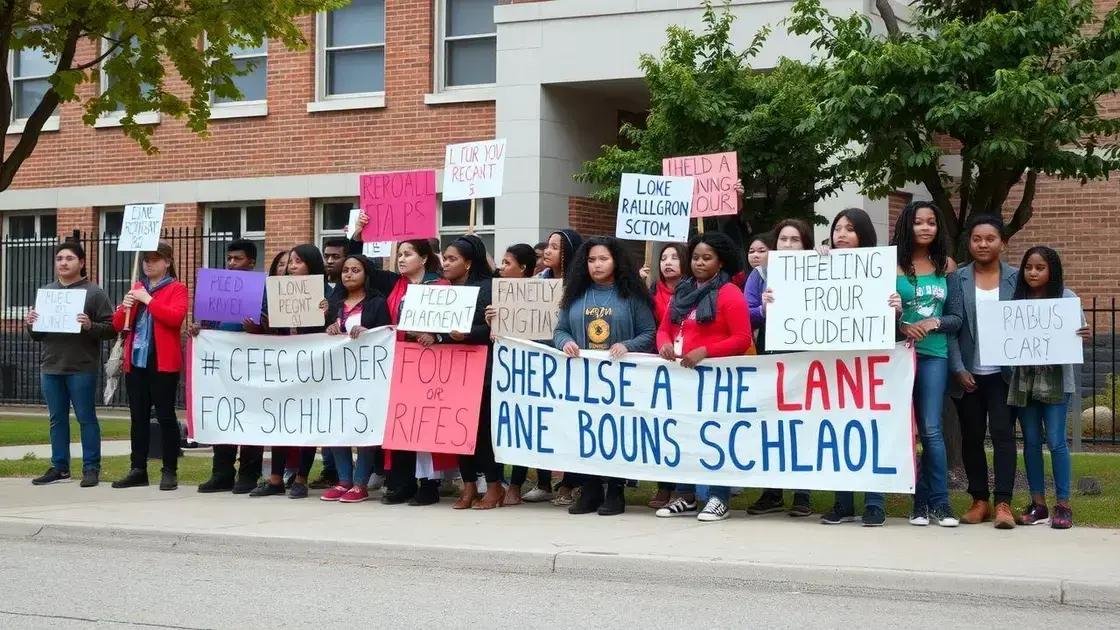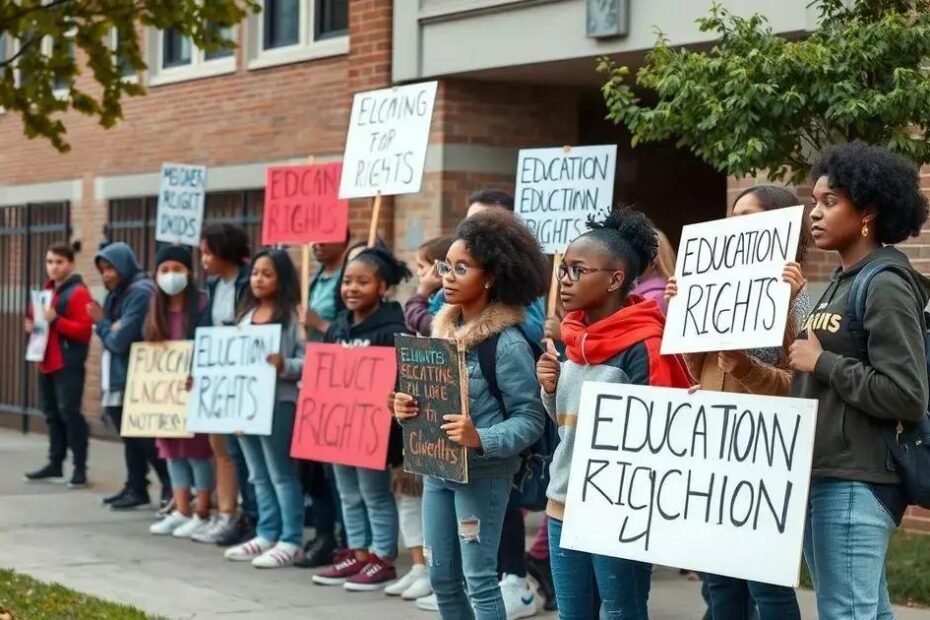Legal rulings on protests in schools establish students’ rights to free speech and assembly while requiring schools to maintain a safe learning environment, shaping how student activism is managed.
Legal rulings on protests in schools can significantly influence how educational institutions respond to student activism. Have you ever considered how these decisions shape students’ rights and school policies?
Understanding legal precedents on student protests
Understanding legal precedents on student protests is essential for grasping how student voices are protected in educational settings. These precedents shape the landscape of student rights, especially during times when students express their opinions through protests.
Important Supreme Court Cases
Throughout history, several pivotal Supreme Court cases have influenced students’ rights to protest. Each case sets a vital precedent that schools must consider when responding to student activism.
- Tinker v. Des Moines Independent Community School District (1969): This case established that students do not lose their constitutional rights to freedom of speech at school. It affirmed their right to protest as long as it does not disrupt the educational process.
- Hazelwood School District v. Kuhlmeier (1988): This ruling allowed schools to exercise some control over student expression, especially in school-sponsored activities, raising questions about where the boundaries lie.
- Morse v. Frederick (2007): Often referred to as the “Bong Hits 4 Jesus” case, this decision stated that schools could limit student speech promoting illegal drug use, demonstrating the balance between student rights and school policies.
These cases illustrate the complexity of student speech rights and how courts balance them against the interests of educational institutions. Schools must navigate these rulings carefully, ensuring they respect students’ rights while maintaining order.
Impact on School Policies
Legal precedents affect school policies regarding protests, leading schools to create guidelines that comply with court rulings. These guidelines are designed to comply with legal decisions while ensuring that protests remain safe and orderly. Schools often adopt the following policies:
- Establishing designated protest areas to minimize disruption.
- Providing clear information on the rights students have during protests.
- Training staff to handle protests responsibly and safely.
Through these policies, schools can support students expressing their views while maintaining an environment conducive to learning. Understanding the legal precedents helps students, parents, and educators grasp their rights and responsibilities regarding protests.
Key court cases affecting school policies
Key court cases affecting school policies play a significant role in defining how schools can regulate student expression. These decisions help shape the legal framework around student protests and set important precedents.
Landmark Cases Overview
Several landmark cases illustrate the ongoing battle between student rights and school authority. Each case provides insights into how courts evaluate the balance between these competing interests.
- Tinker v. Des Moines (1969): This case is foundational, establishing that students maintain their rights to free speech within the school environment. It emphasized that schools cannot censor student expression unless it significantly disrupts educational activities.
- Bethel School District v. Fraser (1986): Here, the Supreme Court held that schools could prohibit lewd speech at school-sponsored events. This case illustrates the limits of free speech in the context of appropriate school conduct.
- Hazelwood v. Kuhlmeier (1988): This ruling allowed educators to exercise control over school-sponsored publications. It highlighted that schools could set standards for student expression that align with their educational mission.
- Morse v. Frederick (2007): Often linked to drug-related speech, this case reinforced schools’ rights to regulate speech that promotes illegal activities, showing the caution exercised regarding student expression.
Understanding these key cases is vital for students and educators alike. They reveal how the judiciary interprets the Constitution in the context of education, which is crucial in today’s environment where student voices are increasingly vocal.
Implications for School Policies
The outcomes of these cases have significant implications on how schools create their policies. After key decisions, schools often adjust their codes of conduct to ensure compliance with legal standards while trying to maintain a safe learning environment. For example, many schools now outline clear procedures for how protests can be conducted to avoid disruption, respecting both students’ rights and educational goals.
Furthermore, schools may implement training programs for staff to navigate these complex legal waters. The goal is to foster an atmosphere where students can express their opinions without jeopardizing the educational process. This balance is essential for healthy school culture.
Rights of students during protests

The rights of students during protests are crucial in shaping how they can express their views. Understanding these rights helps students navigate the complexities of activism within schools.
Fundamental Rights
Students have fundamental rights, including the freedom of speech and the right to assemble peacefully. These rights protect their ability to voice their opinions, particularly on issues that matter to them. However, there are boundaries to these rights that students should understand.
- Freedom of Speech: Students can express their opinions publicly, but this right is not absolute. It should not disrupt the learning environment or infringe on the rights of others.
- Right to Assemble: Students can gather peacefully to protest. Schools may set rules about when and where assemblies can occur, but these rules should not unjustly limit student rights.
- Protection from Retaliation: Students should feel safe expressing their views. It is illegal for schools to retaliate against students for participating in protests.
Understanding these rights is vital for students to engage in meaningful activism while remaining within legal parameters. Schools should also educate students about their rights to better empower them in their expressions.
Guidelines for Safe Protests
While students have important rights, they also have responsibilities during protests. Following guidelines helps ensure that protests remain a productive means of expression. It’s important for students to:
- Plan protests that minimize disruption to education.
- Communicate with school officials about their plans to maintain safety.
- Encourage respectful dialogue and avoid confrontations.
By adhering to these guidelines, students can effectively advocate for their beliefs while fostering a positive environment for all.
Best practices for schools handling protests
Best practices for schools handling protests are essential to ensure that student expression is respected while maintaining a safe environment. Effectively managing protests allows schools to uphold students’ rights and promote a constructive dialogue.
Creating Clear Guidelines
Establishing clear guidelines for protests is vital for both students and staff. Schools should outline the procedures for organizing protests, ensuring students know their rights and responsibilities. These guidelines may include:
- Designating specific areas for protests to minimize disruption.
- Setting time limits for protests to avoid interfering with class schedules.
- Encouraging students to communicate their plans with school officials.
Having clear guidelines helps maintain order while encouraging student activism. Students are more likely to engage in protests when they understand the school’s expectations.
Training Staff Members
It is important for school staff to receive training on handling protests. This training should focus on:
- Recognizing students’ rights to free speech and assembly.
- Learning de-escalation techniques to manage potential conflicts.
- Addressing students respectfully while upholding the school’s policies.
When staff are trained, they can better support students during protests, fostering an environment where everyone feels safe and heard. This proactive approach can help prevent misunderstandings and conflicts.
Encouraging Dialogue
Schools should promote open communication between students, faculty, and administration. Encouraging dialogue allows students to share their concerns and express their views without fear. Schools can host regular forums or town hall meetings where students can voice their opinions. This creates a culture of respect and understanding, essential for a healthy school environment.
By implementing these best practices, schools can effectively handle protests while ensuring that students feel empowered to express their beliefs. Balancing student rights and school order fosters a positive educational atmosphere for all.
Future trends in school protest legislation
Future trends in school protest legislation are shaping how education systems will respond to student activism. As society evolves, so too does the legal landscape surrounding students’ rights to protest. Understanding these trends is crucial for students, educators, and policymakers.
Increased Student Activism
One significant trend is the rise of student activism. With social media amplifying voices, students are more empowered to mobilize and express their views. Schools must prepare for this increased activism by evaluating and updating their policies. This shift may lead to new legislation that protects student rights while acknowledging the importance of maintaining a conducive learning environment.
Legislation Addressing Free Speech Rights
There is a growing push for legislation that explicitly protects students’ free speech rights, especially during protests. More states are considering laws that affirm students’ rights to assemble and protest peacefully. This trend reflects a broader societal recognition of the importance of student input in social issues. It encourages dialogue between schools and students, fostering a culture of understanding and respect.
- States like California and New York are leading this movement by drafting bills that reinforce protections for student protesters.
- Such laws may also require schools to provide resources to support peaceful protests, ensuring activities do not disrupt education.
- These changes aim to balance student expression with school integrity, promoting a healthy environment for activism.
As legislation evolves, schools will need to adapt quickly. Educators and administrators must stay informed about these changes to implement strategies that support both student engagement and educational goals.
Emphasis on Conflict Resolution
Another trend is the emphasis on conflict resolution strategies in schools. Instead of punitive measures, there is a movement towards reconciliation and dialogue when protests occur. This approach encourages students to engage in discussions about their concerns while learning valuable conflict resolution skills.
Legislative measures may soon support schools in implementing these strategies. Programs that teach students to express their views respectfully and work towards solutions will likely become part of school curricula.
In conclusion, understanding legal rulings on protests in schools is essential for navigating the complex relationship between student rights and educational policies. As student activism increases, schools must adapt their procedures to support peaceful expression while ensuring safety and order. By fostering open dialogue, creating clear guidelines, and implementing effective conflict resolution strategies, schools can create an environment where students feel empowered to voice their opinions. The future of school protest legislation points towards greater protections for student rights, allowing their voices to play a vital role in shaping educational policies and practices.
FAQ – Frequently Asked Questions about Legal Rulings on Protests in Schools
What rights do students have during protests?
Students have the right to express their opinions and assemble peacefully without disrupting the educational environment.
How can schools effectively manage protests?
Schools can create clear guidelines, train staff, and encourage open dialogue to support peaceful protests while maintaining order.
What are some key legal cases regarding student protests?
Important cases include Tinker v. Des Moines and Morse v. Frederick, which outline students’ rights and the limits of free speech in schools.
How is legislation around school protests evolving?
Legislation is increasingly focusing on protecting student rights, with more states considering laws that affirm students’ rights to protest and assemble.

